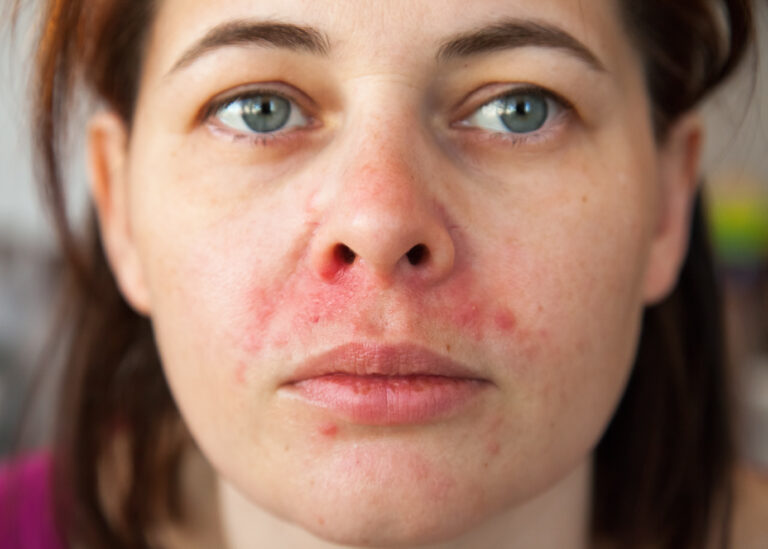Perioral dermatitis is a rash around your mouth that can spread to the areas around your nose and eyes. It most often affects women between the ages of 25 and 45 and can cause painful burning and itching.
Perioral dermatitis is easily mistaken for acne, but it is an entirely different condition that needs specific treatments. It may take some trial and error to find the best approach. If you have a severe case that won’t clear up on its own, consult your primary care physician or dermatologist.
Symptoms and Causes of Perioral Dermatitis
The main symptom of perioral dermatitis is a red rash around your mouth that may be flaky and dry. You may also develop bumps called papules or white, fluid-filled bumps called pustules.1 Some people experience pain and itching. In more severe cases, the rash may extend to the skin around your nose and eyes. Perioral dermatitis is not contagious.
Researchers have identified several possible causes of the condition, including:2
- Topical steroid creams
- Prescription steroid nasal sprays and oral steroids
- Moisturizers and heavy face creams
- Fluorinated toothpaste
- Hormonal changes
- Failure to wash the face properly
It may be difficult to pinpoint what led to your perioral dermatitis. Your doctor can help you review your medical history and personal care habits, so you can make changes to help alleviate the condition.
You should review acne types to compare what you see to the symptoms of perioral dermatitis. The conditions are easy to mistake for each other, and acne will require a different treatment. The more prepared you are when you visit the doctor, the more informed questions you can ask about possible diagnoses and treatments.
Four Perioral Dermatitis Treatments
You and your doctor may not be able to identify the exact cause of your perioral dermatitis rash, but there are several treatments you can try.3 Start with methods that you can easily integrate into your daily life, and make an appointment with your dermatologist to get advice about medications that might help.
Changing Products That May Be the Cause
There is a strong link between perioral dermatitis and topical steroid creams and nasal sprays containing steroids. These types of products can both cause perioral dermatitis and make your symptoms worse.
Be sure to talk to your doctor before you stop using any prescribed steroid medications. They can advise whether it is OK to discontinue their use. You may have to wean yourself off them gradually before you can begin using any topical treatments for your perioral dermatitis.
Dietary and Lifestyle Changes
If you don’t use those products, consider changing other products for your face, such as scrubs, heavy creams, and moisturizers. It might take some trial and error, but you may be able to pinpoint the cause of your perioral dermatitis yourself. If that doesn’t work, you should also try going without makeup around the affected area.
Reduce the number of spicy foods you eat, as they can cause skin irritation around your mouth. Wash your towels, washcloths, and pillowcases in hot water.
Topical Medications
Your doctor might prescribe immunosuppressive creams and ointments to treat your perioral dermatitis. Other topical treatments are available, such as ivermectin and topical antibiotics. Be sure to use ointments and other topical treatments as prescribed. Using more than recommended won’t help your condition clear faster.
Oral Perioral Dermatitis Medications
For more severe cases of perioral dermatitis, your doctor might prescribe oral antibiotics such as doxycycline, tetracycline, or minocycline. Do not use these medications without a doctor’s advice, even if you have a prescription to treat another condition.
Keep in mind that perioral dermatitis is not the same as acne. You cannot simply use treatments such as hydrocolloid bandages to treat it. Talk to your doctor before starting any perioral dermatitis self-care other than changing nonprescription products that might be causing your rash.
Steps To Take if You Suspect You Have Perioral Dermatitis
Unless your first case is very severe, you can try to make changes at home before seeing a doctor for your perioral dermatitis. If you do not see improvement, visit your dermatologist. Ask first about any prescription steroid medications you may be using.
Your doctor can also rule out other causes of skin problems, such as fungal acne. It is very easy to mistakenly self-diagnose conditions of the face, so you shouldn’t take too many steps to address the rash and bumps yourself before seeking professional help.
Doctors can usually diagnose perioral dermatitis with just a visual exam.4 If your doctor is concerned about your condition or wants to rule out other forms of dermatitis, they may also perform a skin biopsy. You can start by talking to your primary care physician about your rash. If they cannot successfully treat it, see a board-certified dermatologist.
Perioral dermatitis clears over time, so try not to get frustrated if you don’t see treatment results immediately.5 It may take a few weeks or even months for the condition to clear.
Learn More About Treating Your Skin Well
Dig into the insightful articles at My Skin Treatment to learn more about dermatitis, acne, and other skin conditions. Our in-depth, physician-reviewed articles help keep you updated on conditions, symptoms, and treatments and can help you achieve clear, healthy skin.
SOURCES:
- Cleveland Clinic: “Perioral Dermatitis.”
- Medline Plus: “Perioral Dermatitis.”
- Healthline: “Perioral Dermatitis: Treatment, How to Cure, and Causes.”
- Everyday Health: “What is Perioral Dermatitis? Symptoms, Causes, Diagnosis, Treatment, and Prevention.”
- American Academy of Dermatology Association: “Red Rash Around Your Mouth Could Be Perioral Dermatitis.”






